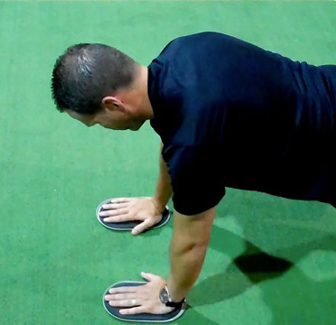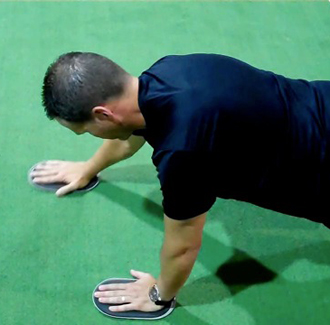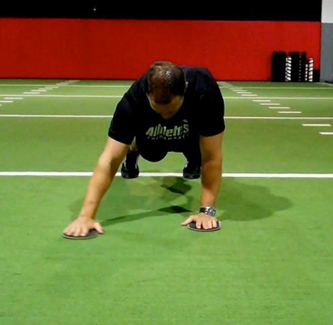
Improving pillar/torso strength should be a primary aim for all fitness programs. Utilizing neutral spine core work to minimize unwanted shear force on the lumbar spine is a safer and often more effective way to train the core, particularly with clients who have tight hip flexors or a history of low back dysfunction. This exercise is another example of such a movement incorporating a sliding movement.
Execution:
Begin in a tall plank position with the feet shoulder width apart and both hands positioned on a slider or Val Slide and directly beneath the shoulders. Slowly perform a clockwise revolution on the right side. Next, repeat the clockwise pattern with the left shoulder. Perform five clockwise repetitions on each side.
Begin with smaller controlled circles to ensure safety and control. Each repetition should last 2-3 seconds. Focus on maintaing a neutral spine alignment and minimizing pelvic rotation. Rest (only if needed or form dictates), and then perform the same sequence in a counterclockwise motion once again alternating arms.
Execution:
Begin in a tall plank position with the feet shoulder width apart and both hands positioned on a slider or Val Slide and directly beneath the shoulders. Slowly perform a clockwise revolution on the right side. Next, repeat the clockwise pattern with the left shoulder. Perform five clockwise repetitions on each side.
Begin with smaller controlled circles to ensure safety and control. Each repetition should last 2-3 seconds. Focus on maintaing a neutral spine alignment and minimizing pelvic rotation. Rest (only if needed or form dictates), and then perform the same sequence in a counterclockwise motion once again alternating arms.
 |  |  |
Application:
This exercise is an excellent way to train anti-extension and anti-rotation strength in the core musculature as well as improve shoulder and hip stability. It is particularly effective for swimmers, gymnasts, overhead athletes, and anyone with a history of shoulder instability.
Progression:
To increase the difficulty, first consider placing the feet closer together to reduce the base of support. Additionally, consider using one slider at a time (other hand is stationary) and completing all circular repetitions on one side prior to changing to the other shoulder. This will increase time under tension on the affected side and add considerably more rotational stress.
Regression:
For those with difficulty holding a tall plank or bearing full weight through the wrists, perform a modified version on the knees. In this instance, position the hands above the shoulders at an angle that sufficiently engages the core while still allowing for proper form.
Brian Schiff, PT, OCS, CSCS, is a licensed physical therapist, respected author and fitness professional. Currently, he serves as the supervisor at Athletes' Performance at Raleigh Orthopaedic. Brian presents nationally at several professional conferences and seminars on injury prevention, rehab and sport-specific training. For more cutting edge training information, subscribe to his monthly Training & Sports Medicine Update at www.BrianSchiff.com.















